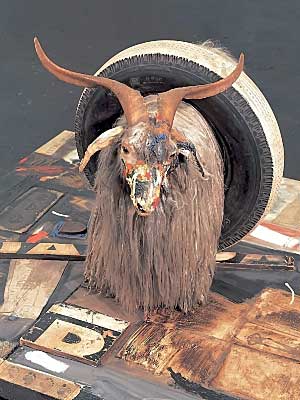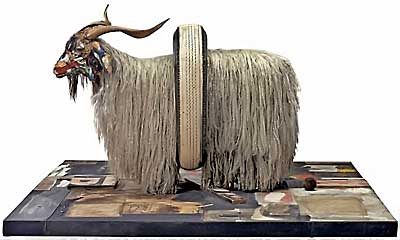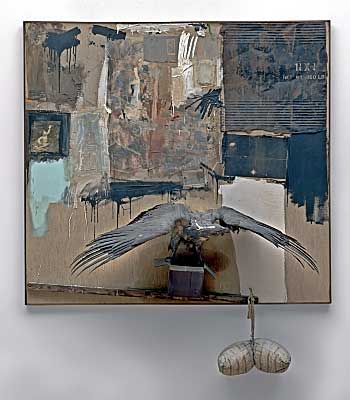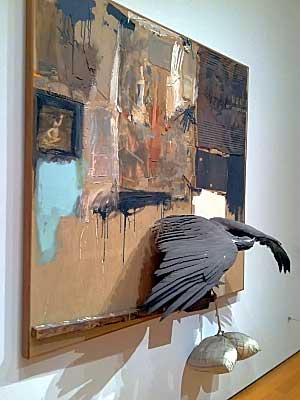3D Art
Lifecast Combine Project
"My role in society, or any artist's or poet's role, is to try and express what we all feel. Not to tell people how to feel. Not as a preacher, not as a leader, but as a reflection of us all." - John Lennon
"Art is not what you see, but what you make others see" - Edgar Degas
Theory
Making a sculptural artwork often requires a great deal of thought, planning and the skilful use of tools, adhesives and hardware. This is especially true when combining different objects and materials, like Robert Rauschenberg did when he created Monogram, an assemblage onto which he fastened a taxidermied, Angora goat wearing a car tire! Rauschenberg used the word "combine" to describe this sort of artwork: one that combines sculptural objects with painted forms. When he made Monogram, the combine went through many iterations over a period of months; sitting in the corner of his studio, with the goat always as the primary element.
Our Lifecast Combine Project will introduce you to a wide variety of tools and techniques, leading to the creation of a sculptural wall–relief, very different than Monogram (which cannot be hung on a wall), but no less challenging. Follow these links to learn more about Monogram: Images at Rauschenberg Foundation; Audio at MoMa.
Project Description
OBJECTIVE: Use found objects, textured materials and acrylic paint on a hardboard support to create a high–relief (or low–relief) combine. For subject matter, your work must include at least one lifecast component that reveals some aspect of your personality. Try to reach past the superficial persona that you project to the world on a daily basis — being a sports fan, chill, ready to party, studious, trying to be likeable, etc. — and choose imagery, poses, facial expression, materials and objects that help you to express your deepest fears, fondest desires or worst memories.
PROCEDURE: To prepare for this project, you should spend at least one week collecting interesting materials that can be used in a metaphorical way. For example: razor blades and tacks might be used to represent sharp pain; broken dishes might be used to represent domestic upheaval; a pile of chicken bones might represent death and decay. Some objects and textured materials can be salvaged from your basement, garage, attic or from around the house. You may also want to visit dollar stores and second–hand stores like Value Village to obtain inexpensive objects that can help to tell your story.
Next, create a waste mould of your face (and limbs if necessary) using plaster-impregnated gauze. Prepare the mould with release agent and then cast plaster into it. When the plaster has set, de–mould your lifecast and clean it up.
When you're ready with your cast, textured items and objects, experiment with a variety of compositions by placing things in different positions on the hardboard. Your textures and objects should interact with your lifecast to imbue the overall work with a narrative quality. For example, a fringe of fun fur surrounding your cast might create animal–like associations; surrounding your lifecast with circuit boards and machine parts could create associations with technology or science–fiction.
When your cast(s) and objects are ready and you've decided where they will sit on the hardboard support, draw a faint pencil line around them on the board. CAUTION: Avoid creating a "bull's eye" by placing it smack in the centre of the board. Notice in the image above (Rauschenberg's combine, Canyon), the raven is placed very near a "sweet-spot" and away from the centre of the composition (review my lecture about "the Rule of Thirds & the Fibonacci Series"). Use a strong adhesive, such as LePage® PL400 (PL Premium is better, but more expensive) or Gorilla Glue® (expanding polyurethane) to connect your cast to the support.
Examples of Student Work, Hands
Examples of Student Work, Faces
Note
TECHNICAL: Depending on the weight and the composition of the rest of your objects and materials, you will need to attach them with carpenter's glue, white glue, PL400 / Premium, silicone, expanding polyurethane or hot glue. NOTE: The PL adhesives and expanding polyurethane always work best for anything made of plaster, except when attaching broken parts (like fingers), in which case the white glue is superior. Also, if your objects and materials are awkward or heavy, it will be necessary to use mechanical fasteners such as low-root screws, drywall screws and pop-rivets (I will assist you with this task).
AESTHETIC: Your finished work must exhibit a comprehensive understanding of the compositional principles of Emphasis, Variety, Balance, Unity, Rhythm, Proportion and Scale. Your work will also show that you have attended to the details of creating a stable and well-finished lifecast with convincing humanoid features. Your cast(s) and objects must also be affixed to the support in such a way that excess PL400 glue and mechanical fasteners are hidden and all surfaces are clean and free of defects.
Further Research
I would recommend this video about art from an excellent series:
- Robert Rauschenberg: Pop Art Pioneer - Full Documentary (BBC, 2016 | 59m 08s)




.jpg)
.jpg)
.jpg)
.jpg)
.jpg)
.jpg)
.jpg)
.jpg)
.jpg)
.jpg)
.jpg)
.jpg)
.jpg)
.jpg)
.jpg)
.jpg)
.jpg)
.jpg)
.jpg)
.jpg)
.jpg)
.jpg)
.jpg)
.jpg)
.jpg)
.jpg)
.jpg)
.jpg)
.jpg)
.jpg)
.jpg)
.jpg)
.jpg)
.jpg)
.jpg)
.jpg)
.jpg)
.jpg)
.jpg)
.jpg)
.jpg)
.jpg)
.jpg)
.jpg)
.jpg)
.jpg)
.jpg)
.jpg)
.jpg)
.jpg)
.jpg)
.jpg)
.jpg)
.jpg)
.jpg)
.jpg)
.jpg)
.jpg)
.jpg)
.jpg)
.jpg)
.jpg)
.jpg)
.jpg)
.jpg)
.jpg)
.jpg)
.jpg)
.jpg)
.jpg)
.jpg)
.jpg)
.jpg)
.jpg)
.jpg)
.jpg)
.jpg)
.jpg)
.jpg)
.jpg)
.jpg)
.jpg)
.jpg)
.jpg)
.jpg)
.jpg)
.jpg)
.jpg)
.jpg)
.jpg)
.jpg)
.jpg)
.jpg)
.jpg)
.jpg)
.jpg)
.jpg)
.jpg)
.jpg)
.jpg)
.jpg)
.jpg)
.jpg)
.jpg)
.jpg)
.jpg)
.jpg)
.jpg)
.jpg)
.jpg)
.jpg)
.jpg)
.jpg)
.jpg)
.jpg)
.jpg)
.jpg)
.jpg)
.jpg)
.jpg)
.jpg)
.jpg)
.jpg)
.jpg)
.jpg)
.jpg)
.jpg)
.jpg)
.jpg)
.jpg)
.jpg)
.jpg)
.jpg)
.jpg)
.jpg)
.jpg)
.jpg)
.jpg)
.jpg)
.jpg)
.jpg)
.jpg)
.jpg)
.jpg)
.jpg)
.jpg)
.jpg)
.jpg)
.jpg)
.jpg)
.jpg)
.jpg)
.jpg)
.jpg)
.jpg)
.jpg)
.jpg)
.jpg)
.jpg)
.jpg)
.jpg)
.jpg)
.jpg)
.jpg)
.jpg)
.jpg)
.jpg)
.jpg)
.jpg)
.jpg)
.jpg)
.jpg)
.jpg)
.jpg)
.jpg)
.jpg)
.jpg)
.jpg)
.jpg)
.jpg)
.jpg)
.jpg)
.jpg)